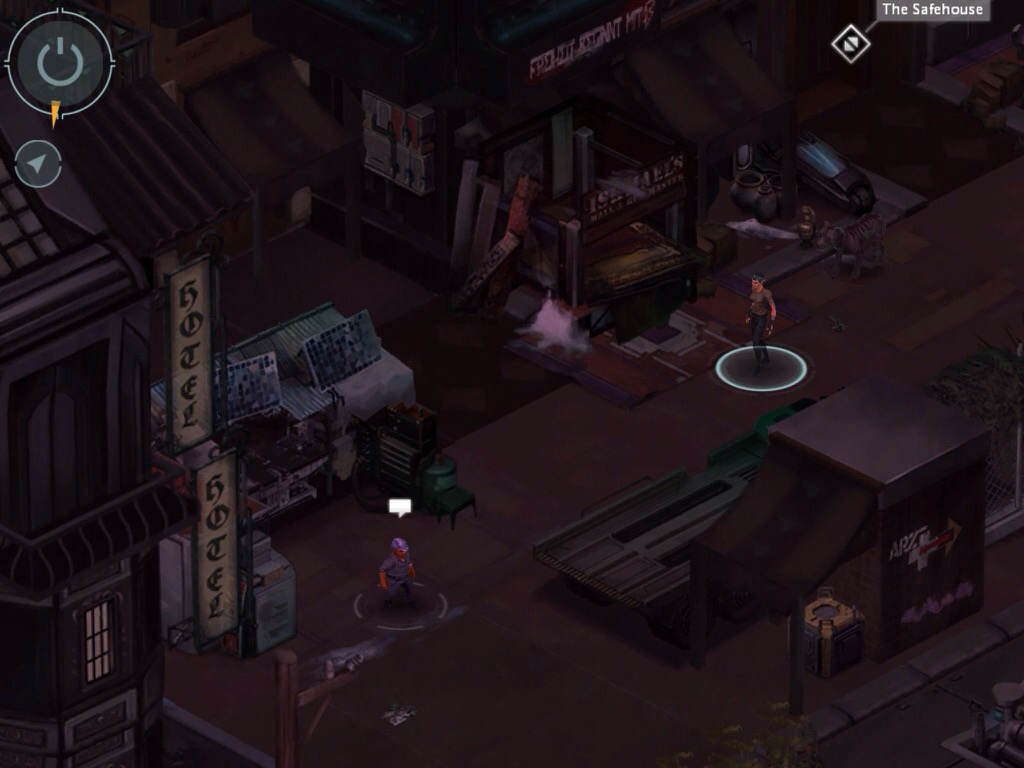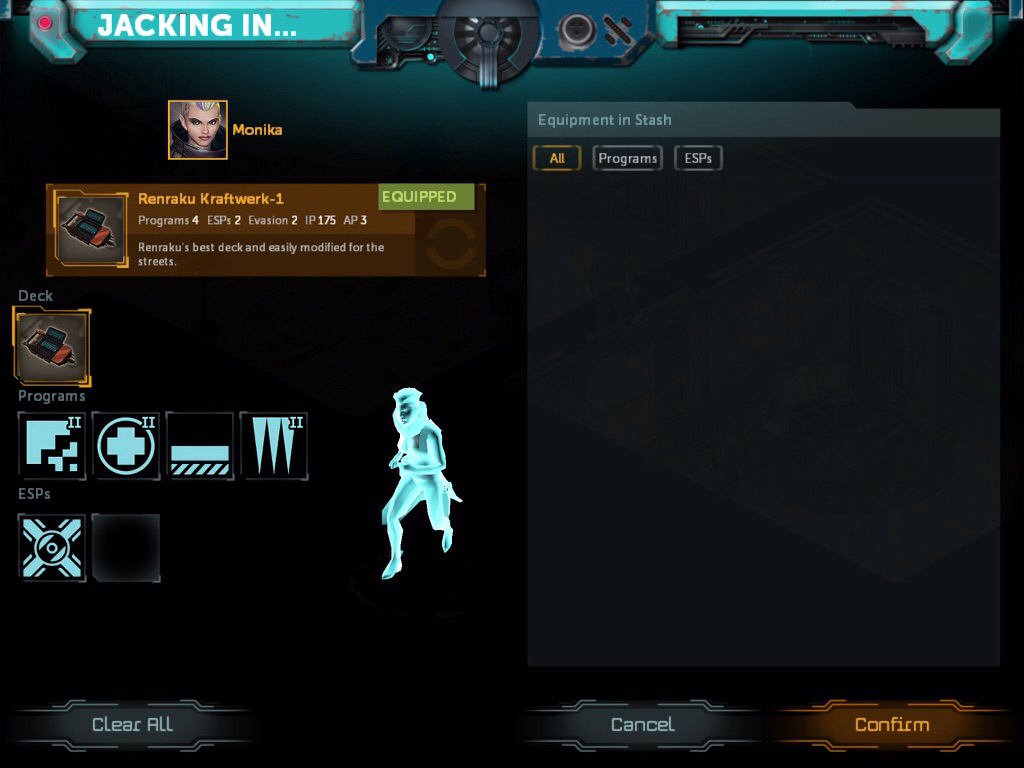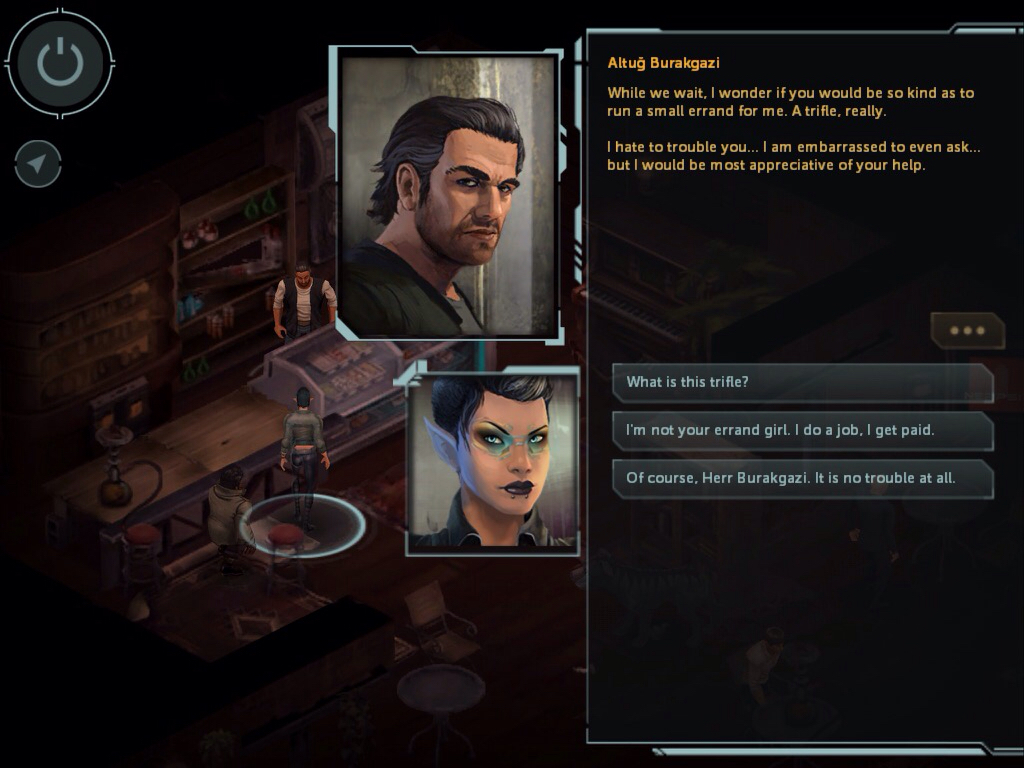![]() I’m of two minds about Shadowrun Returns ($1.99), the 2013 Kickstarter-fueled return to the cult cyberpunk setting. On the one hand, it’s a really strong RPG that pays respect to the beloved 16-bit games. The pacing is snappy, the systems are enjoyable to play around with, and while the setting isn’t quite as unique as it was twenty-five years ago, it’s still unusual enough to help invigorate the experience. I mean, this vision of a dystopian cyberpunk future is almost adorably retro at this point, like looking back at the 1960s idea of where the space race would lead us. The writing quality is strong enough that those feelings of quaintness are quickly shaken as you get into the plot. On the other hand, the iOS release was extremely buggy at launch, the developer was slow to fix anything, and it’s still missing content from the PC version, a situation that will likely never be resolved. The game has a tendency to grab you by the wrist and drag you along, with little in the way of role-playing options or any real agency on your part. That’s a valid choice and I enjoy many games that use that kind of design, but at least where I’m concerned, I tend to feel that Shadowrun RPGs are best when they’re a bit more open-ended.
I’m of two minds about Shadowrun Returns ($1.99), the 2013 Kickstarter-fueled return to the cult cyberpunk setting. On the one hand, it’s a really strong RPG that pays respect to the beloved 16-bit games. The pacing is snappy, the systems are enjoyable to play around with, and while the setting isn’t quite as unique as it was twenty-five years ago, it’s still unusual enough to help invigorate the experience. I mean, this vision of a dystopian cyberpunk future is almost adorably retro at this point, like looking back at the 1960s idea of where the space race would lead us. The writing quality is strong enough that those feelings of quaintness are quickly shaken as you get into the plot. On the other hand, the iOS release was extremely buggy at launch, the developer was slow to fix anything, and it’s still missing content from the PC version, a situation that will likely never be resolved. The game has a tendency to grab you by the wrist and drag you along, with little in the way of role-playing options or any real agency on your part. That’s a valid choice and I enjoy many games that use that kind of design, but at least where I’m concerned, I tend to feel that Shadowrun RPGs are best when they’re a bit more open-ended.
With all that said, a couple of patches down and a ridiculous price drop or two later, it’s an easy recommendation to any iPad-owning RPG fan, even with its faults. Most importantly, the developer seemed to have heard the criticisms of the original game when they sat down to create its first expansion, Shadowrun: Dragonfall – Director’s Cut ($2.99). On iOS, this is a stand-alone release of the Director’s Cut, and that’s probably the most natural way to present it. The game’s setting and story are almost entirely disconnected from the original. Instead of Seattle, you’re in Berlin. While your personally-created runner might be the same one from the first game if you want to stretch your imagination far enough, they’re just as easily someone entirely new. The mechanics are nearly identical to those in the original game, making it all the more impressive just how different Dragonfall feels.

In case you haven’t played the other Shadowrun games, let’s go over the basic details. The Shadowrun games are based on a pen and paper RPG created by BattleTech publishers FASA in the late 1980s. The setting is a bizarre hybrid of dystopian cyberpunk and traditional fantasy. Basically, plug orcs, dragons, and elves into Blade Runner with a healthy layer of Snow Crash and you’ve got Shadowrun. The title refers to secret operations that are carried out by people known as runners. FASA made some pretty good connections back in the day to have video games produced based on their licenses, with the most famous fruits of that being the classic Mech Warrior series of games. Shadowrun had a couple of games made for the 16-bit consoles, and in a break from the norm, they were completely different from each other. Both were RPGs, however, and the shared setting helped create a feeling of consistency between them.
At release, they were critically-appreciated for their quirky nature, but undeniably niche when it came to market performance. The games have been played by many since then, and are now considered cult classics. We’ll save the rest of the history lesson for a later date, but suffice it to say, fan demand for more RPGs in the setting was very strong, and Kickstarter helped the original creator of Shadowrun make that happen. Shadowrun Returns, and by extension Dragonfall, are not identical to the 16-bit games, but they hit most of the right notes. Done up as isometric RPGs, the games feature light exploration interspersed with tactical turn-based combat. You can customize your character to an almost ridiculous extent, leading to very different playstyles depending on what you emphasize. Unfortunately, I felt that Shadowrun Returns didn’t make the most of this customization due to its linearity, but that’s one of the main areas where Dragonfall diverges.

The back story has you playing as a runner of your own design who recently moved to Berlin after a job gone awry. You join up with an old associate of yours named Monika who leads a crew of her own. On a supposed milk run mission, something goes very wrong, with your team stumbling on secrets that they might have been better off not uncovering. It’s up to you to pick up the pieces and figure out what is going on. That same crew will be by your side through thick or thin as long as you don’t get anyone killed, and their presence is one of the more pleasant ways Dragonfall improves on its predecessor. It was hard to get attached to characters in Shadowrun Returns since they were either generics or not around for very long. Here, you’ll get to learn an awful lot about your teammates, and whether you love them or hate them, you’ll at least feel something towards them. This attachment helps add a bit more tension to the combat, even though you can’t really lose anyone permanently except through the plot.
Better still, it gives you options. Dragonfall feels a bit more like a Bioware RPG in that your teammates all have things they need to resolve. You can ignore that for the most part if you want, but if you go digging, you’ll find plenty of rewarding character development waiting for you. The structure of the game also resembles that of the games from Canada’s favorite RPG developer. While the opening is fairly linear, the game opens up significantly once you reach a certain point. You’ll work from a hub area, taking on missions in whichever order you’d like. This goes on for quite a while before the game needs to pull you back on the rails for its exciting conclusion. That end comes far later than it did in Returns. Dragonfall is probably twice the length of that game, yet still manages to maintain its solid pacing and captivating storytelling. As is usually the case in this setting, there are a couple of solid twists along the way that should have you reeling, and everything is told with a suitably cheesy but fun to read tone.

From an atmosphere point of view, it improves on its already strong predecessor, but it still suffers from one of its main weak points. The characters feel believable enough, and the dialogue reinforces the world, but the sets let things down a bit. Areas are a bit too small and empty, feeling more like movie sets than actual places. Oh, the details are done well, to be sure. Everything looks used and dirty the way it ought to, but it somehow also feels sterile, more like a museum exhibit of dystopian Earth than the real thing. I know a lot of that is down to the budget and the scope that it necessitated, but it’s especially noticeable in a game that’s more open the way Dragonfall is. All of the artificial barriers that keep the scant number of residents firmly roped in feel completely arbitrary, as though one good shove could send the whole thing toppling over.
That’s probably the only serious weak point in the game, though. Everything else is a treat. The combat is intense, strategic, and just plain fun. The AI has its quirks but the game’s difficulty seems built to accommodate them, so it’s not much of a detriment to the overall experience. The cyberspace aspect of the game meshes well with the regular combat, playing fast and loose with time itself in ways that add even more excitement. You have total control over how your character develops, allowing you to make them a tech-savvy decker, a rough and tumble melee specialist, a gun-toting brute, or even someone who punches people to death like it’s nothing because nature, man. Each of these builds offers something different to the group, and you’re free to experiment because any paths you choose to leave unexplored in your development are generally covered by at least one other member of your squad.

The controls work very well here, just as they did in the last game. It feels like it was designed around tablet play, and that hotly-contested save issue from the last time around has been addressed right of the gate. You can save anytime you want, though the game will auto-save at various times if you’re the careless sort. Speaking of careless, be very careful if you have to suspend the game for any reason. Just about anything will push Dragonfall out of memory on most iPads, so always save before you quit playing. On the whole, it’s a considerably less buggy experience than the original release was, with a recent patch plugging most of the worst holes in the game. That’s not to say it’s flawless in that regard. The game sometimes gets bogged down with slow loading and choppy scrolling, and older devices might suffer crashes here and there.
Generally, when I talk about RPGs, I find myself sorting them into little boxes. There are many games I love for their interesting stories and characters, and other games where I fell in love with the gameplay systems and compelling designs. The less common category includes games that balance both sides of that equation well, and I feel pretty confident in chucking Shadowrun Dragonfall in that box. People who play RPGs for character customization and fun battles will be quite satisfied, while those who just like to get into a good story with characters you grow attached to are also going to have an excellent time. This is an altogether greater experience than Shadowrun Returns, and I’m extremely impressed at the improvement on the developer’s part. I’m only sad that iOS gamers won’t get to see the next step in that improvement with the series shifting over to computers exclusively, but given how much this game seems to be bursting at the tech seams already, I guess I can’t blame them. That shouldn’t dissuade you from picking up this superb stand-alone gem, however.